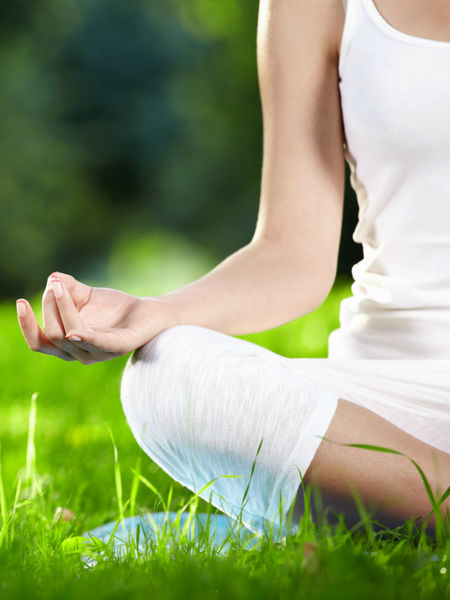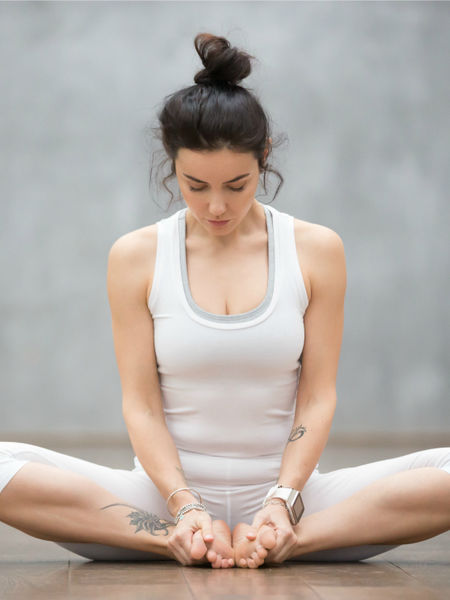Yoga Break 11: Let Us Lotus


When someone says "yoga," the first thing that comes to mind is Lotus pose.
It’s the one that can take the longest to achieve, due to how flexible you must be in your hips, knees, and ankles to get into the pose—let alone sit comfortably for the desired length of meditation.
Working on Lotus before bed every night is one of the best ways to help with all of the above. If you’re already spent and world-weary from the day, then take this time to re-collect yourself, bringing all your energies and body parts back to center. This serves the additional biological benefit of releasing those stress-tightened muscles within your hips, so that you’re already relaxed before you hit the sheets.
It helps the mind as well. As you sit in Lotus, this is your chance to breathe through everything that’s been going on. Inhale the positive: goals, hopes, dreams, the delicious anticipation of Earl Grey the next morning. Pair each inhalation with an exhale of the negative: fears, worries, misgivings. Find release in the solace when your eyes are shut. Lotus is here for you.
Ideally, when you wake up, your legs will feel slightly less hungover by default, and if you pair this practice with other leg-stretching poses such as Downward Dog, then you’ll be even more ready to get into your day.
With such an internal, calming pose, it makes sense to have it with an internal, calming tea: Lemongrass Ginger.
Lemongrass is a powerhouse. As an herb, it possesses substantial anti-inflammatory and anti-bacterial action, and is noted in Ayurvedic medicine for easing digestion. This makes it pair wonderfully with ginger, which is also a good stomach-softener and—y’know, helps things along, stimulating gut function along with a healthy appetite.
When it comes to sip-savoring, the wonderful thing about lemongrass and ginger is how well they play together in a tea. The "lemony" notes of Lemongrass—from the citral compound—are soft enough to meld with the heat of ginger, keeping the zingy root from rasping too harshly on the tongue. When you’re looking to add a citrus lilt to your own blend-bending, lemongrass is a great choice to preserve the subtle qualities of vegetal green and green rooibos teas, without turning the overall blend into a lemonade stand.
So, let’s take all that lovely stuff within our cup, and pour it into Lotus.
Step 1. Time-honored tradition: tea (bags or loose), strainer (or infuser), drinking device, and hot water. For an herbal tea, think about it as if you were actually about to cook those herbs and spices. With one such as Lemongrass Ginger, those hardy plants needs the same treatment as if you were infuse their flavors into a waiting dish. This means absolutely boiling water—approximately 212 degrees Fahrenheit—and a good long steep of 4-5 minutes. Lemongrass especially needs extra coaxing to bring out its voice in the cup. Understeeping this tea will result in a lighter drink, with fewer calming/digestive effects.
Bring out your yoga mat as well, and assemble the flow in your mind as you prepare the tea and wait for the water to boil. Lotus is a good finishing pose, so you’ll want to warm up your stuff hips with previous Yoga Break poses.
Step 2. When the water is ready, set the tea to steep and step onto the mat.
The length of time it takes to bring the most out of these herbs is plenty of time to ease through your flow. Explore new angles in your body. Stretch, extend, contract. Fee the interplay of muscles, sinews, ligaments, tendons. Enjoy the sensations of your soft tissues.
Step 3. Step off the mat and fill your cup to your heart’s content. A ratio of eight ounces to one heaping teaspoon of tea will yield a nice, solid beverage. Bear in mind that most mugs are far more than eight ounces, so if you don’t know how much is yours, then assume ten minimum, sixteen maximum tea capacity.
Return to the mat with your cup of tea, setting it beside you at a safe, reachable distance.
Step 4. Fold yourself into a cross-legged position. If this is just barely comfortable—we’ve got a nation of tight hips, after all—then this is fine. Let it be your Lotus.
If you find that you have a little more give in your hips and knees, see what it feels like to cross one leg on top of the other, so that the foot rests on your thigh or the crease of the hip.
Depending on your level of flexibility, you may bring the other foot up into its space between your hip and your thigh. This, however, is not achievable by most people, so don’t feel frustrated if you’re still working on it after two or more years. You never want to cram yourself into the pose by tugging your extremities into place. Just go with the progression that works for you.
Step 5. Breathe. Sip. Feel the tea circulate through your happily-aligned system. And if your system doesn’t feel aligned or happy—that’s still ok. There’s no perfect in us, no perfect in tea, no perfect in yoga.
Just keep sipping. Keep breathing.
Peace and cheers.
Dedicated to the study of health and wellness, Natasha Nesic is a Certified International Tea Masters Association Tea Sommelier and Certified Personal Trainer by the National Academy of Sports Medicine. She trains, writes, and consults throughout New York and has a passion for pairing tea with the unexpected: movement, music, and coffee.
Cheers!
Natasha Nesic
NASM Certified Personal Trainer and Nutrition Coach, Founder of Work Life Fitness
